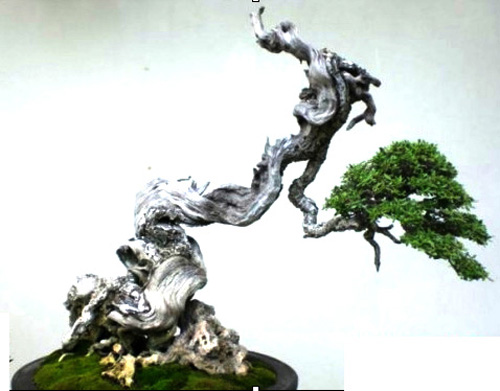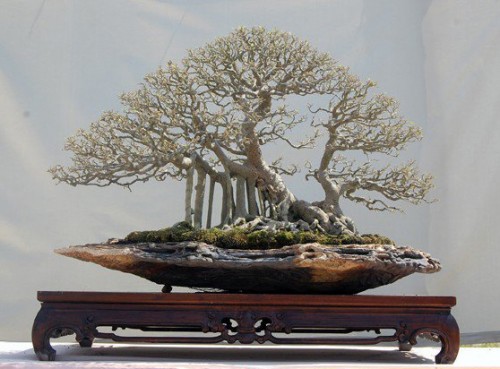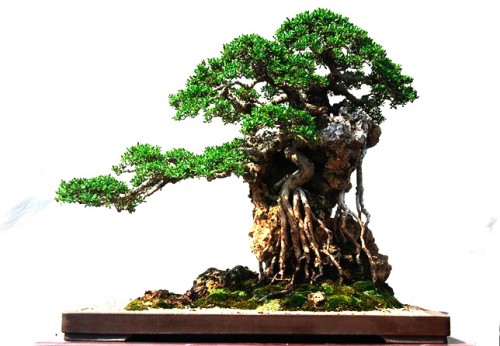
Graceful simplicity contrasted with a wild shape and texture make for a striking bonsai. I lifted this photo off of a facebook page titled ‘Bonsai Indonesia‘ by Silky Jemiran. The owner is listed as Zhylonk Kiakiz Alfarizhy. I did not commit the sin of chopping off the pot, though I did adjust the image to take out background noise.
Sherlock Holmes
Sometimes tracking down the real owner of a bonsai that appears on facebook requires the imagination and determination of a Sherlock Holmes. Even then, you can’t always be sure you’ve got it right.
Problem solved?
When I first saw the tree above, I thought it might belong to Silky Jemiran. Then I noticed that he listed the owner (see above). He also listed the owners of the two trees below. Problem solved (provided Silky got it right). However, in many cases, the owner isn’t listed and you might assume (often incorrectly) that the person who posts the photos is the owner. This is where Sherlock Holmes comes in handy.

There’s a lot going on here. Not the least of which are: some very distinctive aerial roots, a funky nebari, excellent ramification, a perfect silhouette and what looks like a very well suited earthy, handmade pot. Silky lists Wayan Suwendra as the owner.

Root-over-rock perfection. Everything works here; including the way the tree and rock merge into one dynamic form and the way the rocks on the left mirror the sweeping horizontal branch. Then there’s the well chosen pot that quietly provides a sense of earth and balance. Silky lists Rudi Julianto as the owner.
The first tree just magnificent, I’m off on a collecting trip this weekend–just maybe there is one out there as (future) nice as these.
D.
Thanks Donna and good luck collecting. Where are you going and what are you looking for?
Love the root-over-rock, what species is that?
It is Pemphis acidula…
Thank you Robert,
I’ve always thought all Pemphis were obtained as yamadori from seaside locations. And, that they are usually always really old specimens often hundreds of years old. Do you think this specimen was produced by burying a sapling in sand and employing the usual techniques for root-over-rock styling; spraying occasionally with seawater. Sorry for all the silly questions – but I have always been fascinated by “Santigi” bonsai, since many are extraordinary, but unfortunately, unavailable in the US. I love that eery, almost Spooky look they have. Few American trees can come even close to this image.
No Owen. Pemphis is very sensitive, so we cannot work too much on the roots like Ficus to create such design. Most of nice Pemphis grows on rock as this as well. Parts of the rock crack off due to the roots growth, then minor carving on the rock is done to expose the roots.
Thanks Robert.
Just to be clear; are you saying that Pemphis is found in nature as a natural root-over-rock? That you collect the tree with the rock? If so, you must have to break off sections of rock along those root cracks you are talking about and collecting them must require quite a bit of skill and know how, especially given the sensitivity of the roots.
Wayne,
Pemphis is growing in two specific locations, sandy beach and rocky coasline. We don’t like the one growing on sandy beach because they lack of character and texture, mostly simply growing straight without natural jin-shari.
The one grows on the rocky coasline. mostly growing on the rocks and most of the roots system are inside the rock,not over the rock. So by breaking the rock with heavy tools is the only way to dick the material and mostly should be brought home with the rock; that’s why we have so many on-the rock design of Pemphis bonsai.
Hi Robert,
Aha. Good explanation. Not the usual way plants are collected, but the results are great.
Thanks